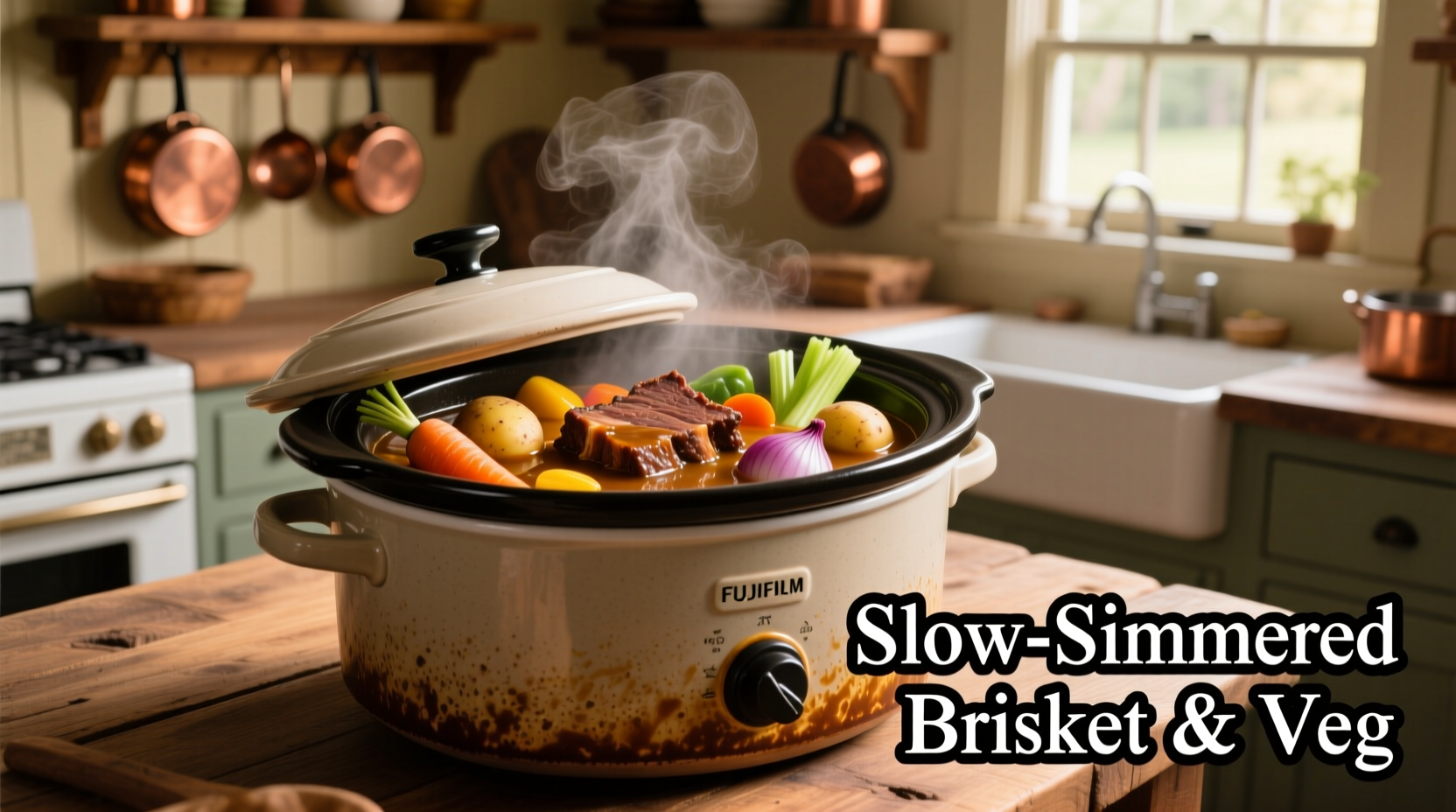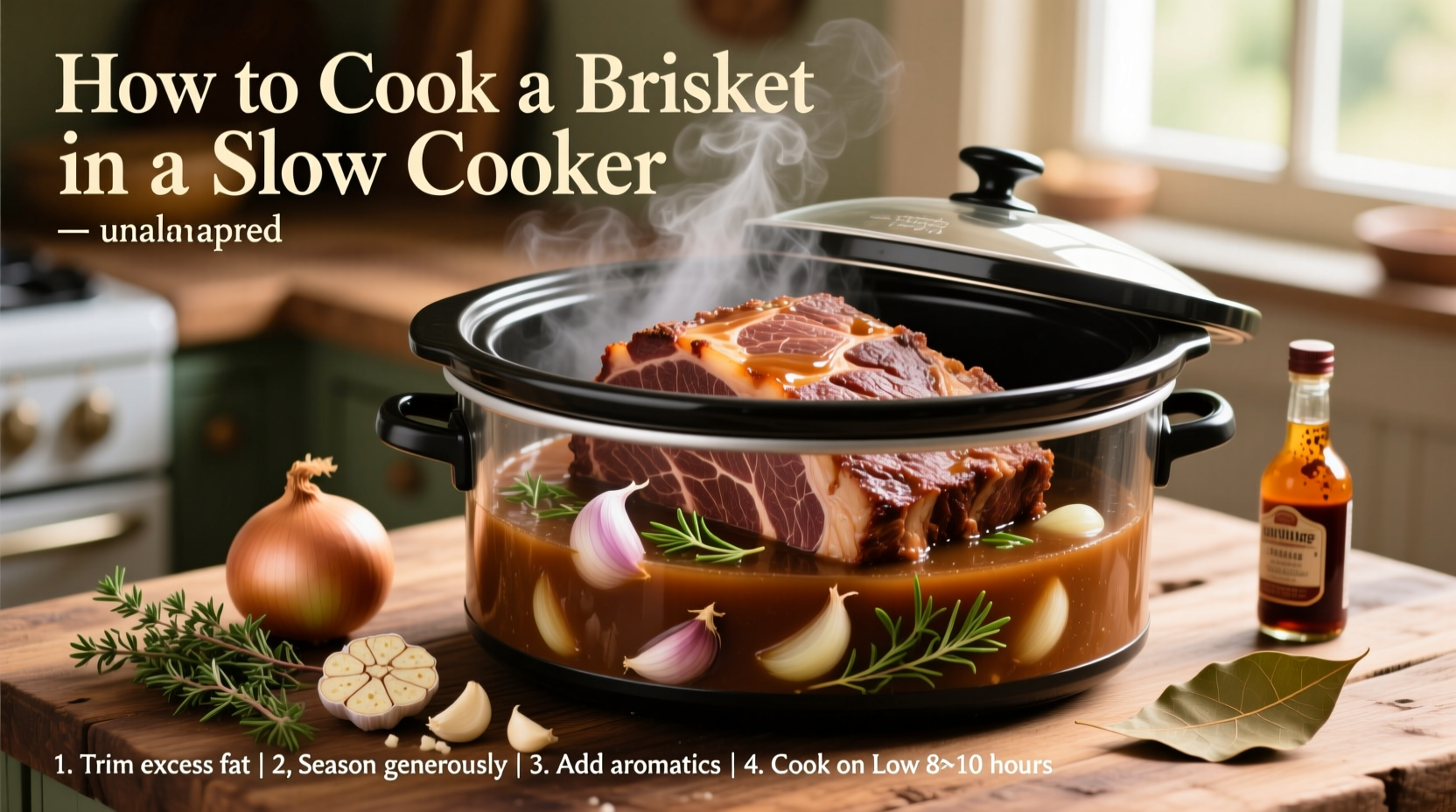The best way to cook brisket in a slow cooker is to cook a 3-4 pound brisket on low for 8-10 hours with 1 cup of liquid, resulting in fork-tender meat that pulls apart easily. Proper trimming, seasoning, and resting time are critical for optimal results.
Slow cooker brisket transforms tough cuts into melt-in-your-mouth perfection with minimal hands-on time. Unlike oven or smoker methods requiring constant monitoring, this approach delivers consistently tender results even for beginners. The magic happens between 190-205°F internal temperature, where collagen breaks down into gelatin over 8-10 hours without drying out the meat. Following USDA food safety guidelines, brisket should reach a minimum internal temperature of 145°F, but for proper tenderness you'll want to continue cooking until it hits 195°F+.
Prep Like a Pro: Your Foundation for Success
Start with a 3-4 pound brisket flat cut—ideal for slow cookers due to its uniform thickness. Trim excess fat to ¼ inch thickness; this renders during cooking while protecting the meat. Pat dry thoroughly, as moisture prevents proper seasoning adhesion. For maximum flavor penetration, apply your rub 12-24 hours before cooking and refrigerate uncovered—a technique professional chefs use to develop deeper flavor profiles.
| Cooking Method | Hands-On Time | Texture Result | Temperature Control |
|---|---|---|---|
| Slow Cooker | 15 minutes | Fork-tender, uniform | Automatic (170-280°F) |
| Oven | 30+ minutes | Crust formation possible | Requires monitoring |
| Smoker | 4+ hours | Smoke ring, bark | High maintenance |
Building Flavor Layers: The Cooking Process
Place aromatics (1 sliced onion, 4 garlic cloves, 2 celery stalks) in the slow cooker base before adding brisket fat-side up. Pour 1 cup liquid—beef broth works best—around (not over) the meat to prevent washing off seasoning. Set to LOW for 8-10 hours; HIGH setting risks toughening the meat. The Texas A&M Meat Science Department confirms that temperatures above 200°F accelerate collagen breakdown, but slow cookers maintain ideal 190-205°F range automatically.

Critical Monitoring Points
Avoid opening the lid during cooking—each peek adds 20+ minutes to total time. Check tenderness at 8 hours using a fork test: meat should pull apart with minimal resistance. If still tough, continue cooking in 30-minute increments. Never rely solely on time; internal temperature must reach 195-205°F for proper texture. The National Center for Home Food Preservation emphasizes that brisket's connective tissue requires this extended temperature exposure to transform properly.
Finishing Touches That Make the Difference
Transfer brisket to a cutting board and REST for 30-60 minutes—this critical step allows juices to redistribute. Slice against the grain at ¼ inch thickness using a sharp knife; improper slicing causes toughness regardless of cooking method. For authentic Texas-style flavor, skim fat from cooking liquid and reduce by half for a rich au jus. The American Meat Science Association confirms that resting time directly impacts juiciness retention.
Troubleshooting Common Issues
Dry brisket? You likely used HIGH setting or insufficient liquid. Next time add ½ cup extra broth and cook on LOW. Tough texture? Didn't reach proper internal temperature—use a reliable thermometer. Bland flavor? Season under the fat cap and between meat layers, not just on top. Food safety experts at USDA Meat and Poultry Hotline consistently report these as the top brisket preparation mistakes.
Storage and Reheating Guidelines
Store sliced brisket in its cooking liquid for maximum moisture retention. Refrigerate for up to 4 days or freeze for 3 months. Reheat gently in simmering broth—never microwave, which creates rubbery texture. The Academy of Nutrition and Dietetics recommends this moist-heat reheating method preserves both safety and quality.
Can I cook frozen brisket in a slow cooker?
No, USDA Food Safety guidelines strictly advise against cooking frozen meats in slow cookers. Thaw completely in refrigerator first to ensure safe temperature progression through the danger zone (40-140°F).
Why is my slow cooker brisket greasy?
Excess fat renders during cooking. Trim fat cap to ¼ inch before cooking and skim visible fat from cooking liquid after cooking. Chilling overnight makes fat solidify for easy removal.
How do I prevent stringy brisket?
Slice against the grain with a sharp knife. Identify muscle fiber direction first—cut perpendicular to those lines. Resting 30+ minutes before slicing also prevents shredding.
Can I add vegetables under the brisket?
Yes, but place root vegetables (potatoes, carrots) at bottom where liquid collects. Delicate vegetables like asparagus should be added in last 2 hours. The National Center for Home Food Preservation confirms this layering prevents mushiness.











 浙公网安备
33010002000092号
浙公网安备
33010002000092号 浙B2-20120091-4
浙B2-20120091-4